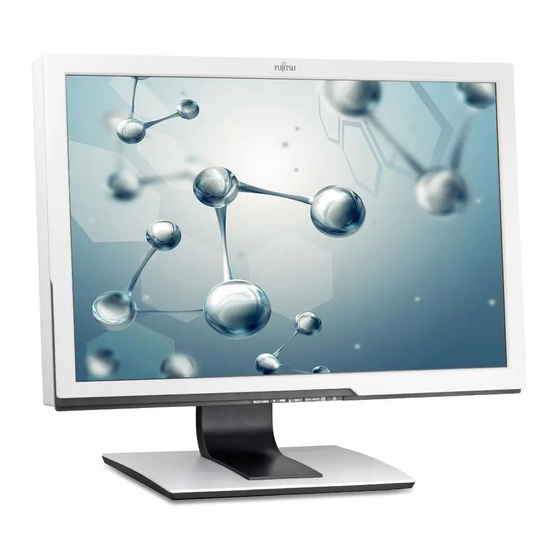
Summarization of Contents
Your LCD screen
Further information
Details on setting resolution and refresh rate for display adapter.
Notational conventions
Explains symbols and fonts used in the manual for clarity.
Important notes
Safety instructions
Essential safety regulations for using the device in an office environment.
Power cable
Guidelines for using and replacing the monitor's power cable.
Transporting the device
Instructions for safely moving the monitor to a new location.
Cleaning the device
Procedures and precautions for cleaning the monitor safely.
CE marking
Compliance with EEC directives for electromagnetic compatibility and low voltage.
Power Management
Information on the monitor's energy-saving mode and power consumption.
Disposal and recycling
Guidance on environmentally sound disposal of the device.
Getting started
Unpacking and checking the delivery
Steps for unpacking the monitor and verifying package contents.
Setting up the device
Instructions for physically setting up the monitor.
Setting up an ergonomic video workstation
Recommendations for optimal monitor placement for ergonomics.
Adjusting height
How to adjust the monitor's vertical height.
Adjusting the inclination
How to adjust the monitor's tilt angle.
Removing monitor base
Steps to detach the monitor base for swivel arm or wall mount.
Connecting the device
Safety and general instructions for connecting the monitor.
Connecting cables to the monitor
Details on connecting various cables to the monitor ports.
Connecting cables to the computer
Instructions for connecting the monitor cables to the computer.
Operation
Switching the device on and off
Guide on how to power the monitor on and off, including LED indicators.
Notes on power management
How the monitor works with computer power-saving modes.
Changing the monitor settings
Overview of how to adjust monitor settings.
Changing the monitor settings with the buttons of the control panel
Direct settings adjustment using monitor's physical buttons.
Performing auto-adjustment of the monitor
How to automatically optimize picture quality and position.
Selecting input signal (D-SUB/DVI-D/HDMI)
Procedure to select the active video input source.
Activate/deactivate ECO operating mode
How to enable or disable the ECO mode to reduce power consumption.
Locking the OSD menu
How to prevent accidental changes to monitor settings via OSD.
Locking the ON/OFF button
How to prevent accidental power cycling of the monitor.
Changing the monitor settings using the OSD menu
Detailed steps for navigating and changing settings via the OSD menu.
Adjusting the brightness and contrast
How to adjust display brightness and contrast settings.
Selecting the application mode
Choosing predefined display modes for different applications (Office, Photo, Video).
Adjusting the picture size and position
How to modify picture dimensions and placement on screen.
Adjusting the volume
Controls for the monitor's integrated loudspeakers.
Setting colour temperature and colours
Adjusting screen colours and colour temperature for optimal viewing.
Setting functions
Configuring various monitor functions like input select and language.
Displaying information
Accessing monitor status details like model and resolution.
Notes on ergonomic colour adjustment
Ergonomic colour combinations
Guidance on selecting suitable colour combinations for text and graphics.
Troubleshooting
No screen display or power issues
Solutions for issues like no screen display or power indicator not lighting up.
No Signal or Frequency Out of Range
Troubleshooting steps for 'No Signal' or frequency range errors.
Picture position and shaking issues
Solutions for incorrect picture position or screen shaking.
Picture wrongly adjusted
How to reset settings or perform auto-adjustment for picture issues.
Picture disturbances
Addressing vertical/horizontal lines and picture noise.
Screen becomes darker
Information on dimming due to backlight lifetime and replacement.
Notes regarding the DIN EN ISO 13406-2 standard
Permanently unlit or lit pixels
Explanation of pixel defects and the ISO 13406-2 standard for limits.
Technical specification
Dimensions and weight
Physical measurements and weight of the monitor.
Electrical data
Power supply, video, and synchronisation specifications.
Environmental conditions
Operating temperature and humidity ranges for the device.
VESA-DDC-compatible VGA interface
Details on the VESA-DDC interface for computer communication.
Preset operating modes
Factory-optimized display modes for optimal operation.
Most frequent operating modes
Common horizontal frequencies, refresh rates, and resolutions.
Video/TV operating modes using DVI and HDMI
Supported resolutions and refresh rates for video inputs.
SUB D port
Pinout and meaning for the SUB D (VGA) connector.
DVI-D port
Pinout and meaning for the DVI-D digital video connector.
HDMI port
Pinout and meaning for the HDMI digital audio/video connector.

















Need help?
Do you have a question about the P26W-5 ECO and is the answer not in the manual?
Questions and answers